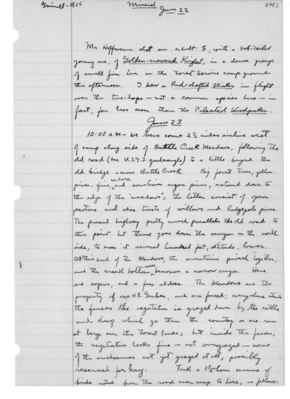Pages That Mention alder
1925: Joseph Grinnell's field notes
S2 Page 38
Collector: Grinnell - 1925 Location: Mineral Date: June 22 Page Number: 2492
Mr. Hoffmann shot an adult male, with a bob-tailed young one, of Golden-crowned Kinglet, in a dense group of small fir here on the Forest Service camp ground this afternoon. I saw a Red-shafted Flicker in flight over the tree-tops - not a common species here - in fact, far less seen than the Pileated Woodpecker.
June 23 10:00 a.m. - we have come 2 1/2 miles airline west of camp along side of Battle Creek Meadows, following the old road (see U.S.G.S quadrangle) to a little beyond the old bridge across Battle Creek. Big forest trees, yellow pines, fir, cedars, and sometimes sugar pines, extend down to the edge of the "meadows"; the latter consist of open pasture and also tracts of willows and lodgepole pines. The present highway pretty much parallels the old road to this point but thence goes down the canyon on the north side, to cross it several hundred feet, altitude, lower. At this end of the Meadows, the mountains pinch together, and the creek bottom ^soon becomes a narrow canyon. Here are aspens, and a few alders. The Meadows are the property of one W. L. Gerber (?), and are fenced; everywhere astride the fences the vegetation is grazed down by the cattle and sheep which go thru [sic] the country or are seen at large over the forest lands; but inside the fences, the vegetation looks fine - not overgrazed - some of the enclosures not yet grazed at all, possibly reserved for hay. Took a 1 1/2 hour census of birds notes from the road near camp to here, as follows:
S2 Page 56
Collector: Grinnell - 1925 Location: Mineral, 4800 ft. Date: June 29 Page Number: 2509
Hermit Thrush nests, with young, previously found, these latter being off the edges of the bog on either side, while the Russet-backs is [sic] in the bog.
Traill Flycatcher's nest just found by Mrs. G.; in willow bog only about 100 yards from the other one found today. Rim only 750 mm. above ground; nest in rather open low thicket, of lush leafage, but surrounded by taller growth of willow and alder; supported on slanting willow stem, with other twigs and leafage. Taken (3/4) along with [female symbol] parent. Male birds keep out of sight in willows; heard to sing in usual fashion. Eggs perfectly fresh.
Saw full fledged young Tolmie Warbler in the willows.
6271 Russet-backed Thrush [female symbol] 29.5 g. With set 1/4 (see p. 2508);
6272 Sierra Hermit Thrush [male symbol] ju. 24.0 g. From brood found on June 20 (see p. 2463). As I touched the nest, the four youngsters, even tho seemingly so undeveloped, decamped in as many directions with cries which brot [sic] the distracted mother. Each went over and under logs and bush with amazing celerity; the nest was forsaken for good - the safest procedure to the average, I suppose, in the long run. I found also that the other nest of this species (see p. 2482) had been left by the brood (of about same age) - save for one dead and partly skeletonized, by ants, in the bottom of the nest.
S2 Page 81
Collector: Grinnell - 1925 Location: Broke-off Mt. Date: July 27 Page Number: 2533
foliage which the breeze kept in disconcerting agitation); Cassin Purple Finch (2 or more, distantly heard and seen in tops of hemlocks); Sierra Grouse (2, as above); Hammond Flycatcher (2 immatures, separately, seen closely in hemlocks at 8000 to 9000 ft.); Junco (2, in hemlocks).*
In the red-fir belt (Canadian), 8000 ft., about, down to 7000 ft., where we left the machine, noted: Deer (doe and fawn at edge of alder thicket); Callospermophilus (2 or more); Thomomys monticola (sign common); Fox Sparrow (one immature near patch of heather along little stream at 8000 ft., and others heard in alder patches); Juncos (commonest bird, one [male symbol] singing at tip of lofty red fir - many full-grown young in scattering troupes); Evening Grosbeak (one family of 5 or so alighted on dead lower branches of a fir and notes of others were heard now and then); Solitaire (one flushed from ground); Siskin (notes of 2 or 3 heard overhead); Blue-fronted Jay (heard several times); Cassin Vireo (2 immatures closely seen in a jungle of white alders); Hammond Flycatcher (weak call notes heard often, and one bird seen, 30 feet or so up in densely shaded branchwork of fir); Wood Pewee (pair at 7000 ft.); Pileated Warbler (song of one heard from alders); Robin (a pair at a little ^moraine lake in the fir woods was noisily concerned at our presence); Audubon Warbler (a family, male singing, in trees at this same lake); Canada Nuthatch (notes heard in the distance).


